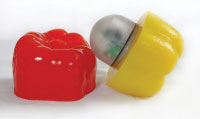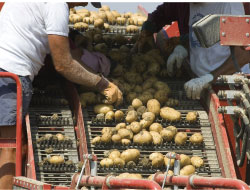
Equipment
Harvesting
Using real-time data to reduce fruit and vegetable bruising: The Smart Spud and Produce QC
to reduce fruit and vegetable bruising
April 23, 2008 By Treena Hein
In 1997, Wayd McNally was lying on
the ground and staring up at the underbelly of a potato harvester in
Prince Edward Island when inspiration struck. McNally, who was running
his own agricultural consulting business, was trying to figure out how
to help the farmer reduce bruising.
 |
| The Smart Spud mimics a potato in weight and size. When in use, it moves alongside real spuds in their travels from the ground through harvest and storage. Sensors on the device transfer immediate real-time data about where and how much the tubers are getting bumped and bruised. Contributed photo |
In 1997, Wayd McNally was lying on the ground and staring up at the underbelly of a potato harvester in Prince Edward Island when inspiration struck. McNally, who was running his own agricultural consulting business, was trying to figure out how to help the farmer reduce bruising.
“I thought, ‘Wouldn’t it be simple just to take something and throw it in the harvester with the potatoes, watch it and know exactly where the problem is so you can fix it?’” he recalled.
The device McNally pictured is now a reality and used by fruit and vegetable farmers across Canada and across the world. The Smart Spud, sold by McNally’s company Sensor Wireless of Charlottetown, mimics a potato in weight and size, moving alongside real spuds in their travels from the ground through harvest and storage, even all the way to the store. Sensors on the device transfer immediate real-time data about where and how much the tubers are getting bumped and bruised – all without interfering with existing processes or equipment – so that immediate action can be taken. Adjustments might include cushioning, slowing down a transfer point or modifying other aspects of harvest or transport.
The Smart Spud wirelessly transmits data on the impact jarring it is receiving to the farmer via a hand-held device, which displays a graph indicating every time the Spud receives an impact above a given threshold. That data can later be downloaded to a computer for record keeping.
The technology is also available in a range of other fruit and vegetable shapes, a product line known as Produce QC (QC stands for quality control). In addition to impact jarring, Sensor Wireless devices are able to measure temperature, humidity, vibration, pressure and GPS-based location. Much of the company’s business lies in providing real-time feedback for the assembly line and transportation of packaged good for companies such as Campbell’s Soup and Coors Breweries.
 |
| The spherical Produce QC unit is similar to the Smart Spud unit and can be used to minimize quality problems with fruit and vegetables such as apples, onions, carrots and even wild blueberries. Contributed photo |
Kevin Marceau, field manager for the Ontario Potato Board (OPB), calls the Smart Spud “a piece of diagnostic equipment essential to the industry.” The OPB bought their first Spud about six years ago and an updated version a few years after that.
“We loan it for free to our 140 growers,” says Marceau. Those growers collectively produce about nine million pounds of potatoes on average every year. “Certainly it’s worth the money to have that available.”
He describes the process of gathering and acting on the Spud’s feedback “a process of elimination. Sometimes [the growers] just want to improve or feel they are doing a good job. Sometimes it’s just peace of mind that they don’t have a problem. If it catches one small problem, it pays for itself.”
In addition to being lent out to growers, the OPB’s “Spud” is also used to check for handling problems at their large storage facility.
Francis Hughes, owner of Emerald Isle Holdings in Kinkora, P.E.I., purchased his Smart Spud about four years ago.
“It paid for itself within the first couple of days probably that we had it,” he said.
The technology is a great value for Hughes’ operation since he grows for Hostess Frito-Lay and the variety of potato grown is “highly sensitive and easy to bruise.” In addition, parts of Hughes’ farm have rocks and clay that tend to be carried along with the potatoes when harvesting, adding to the bruising sensitivity.
Because of this, Emerald Isle has a person using the “Spud” full-time during the approximately 30-day harvest season.
“We use it about a dozen times a day when we’re digging potatoes, on the harvester and all the handling equipment,” Hughes notes. “We usually find belts running too fast or not fast enough, or they’re clipping each other. We also do bruise sampling at the warehouse. If we have under five per cent bruising, we’re happy, but usually we get about two per cent.”
 |
| Potato producers can use the Smart Spud to monitor how much bumping and bruising is happening to tubers during harvest. The real-time data allows adjustments to be made to equipment in the field. |
The growers have had good success receiving service and having technical problems solved. “I had never had any problems with the technology until this year,” said Hughes. “This year I had a problem with the palm pilot, but they called and straightened it out. They’re very good about it.”
“Sensor Wireless has been excellent in terms of technical service,” Marceau adds.
At Oxford Frozen Foods, a large fruit and vegetable processor and exporter in Oxford, N.S., near Halifax, they use a spherical Produce QC unit to minimize quality problems with their onions, carrots and other produce, even wild blueberries.
“Checking impact in dumping for blueberries, that’s where we use it the most,” says process engineer Joe Comeau. It has been particularly useful to check a new dumping system for berries. “It validated some of our suspicions, and we made changes in the speed and rotation,” said Comeau.
Produce QC has only been used about 12 times so far at Oxford Frozen Foods in the two years they’ve had it. Comeau isn’t sure if they’ve achieved cost return yet, but is “inclined to say no.” However, he stresses “I’m not sure we’ve used it to its full potential” because it’s often hard to find the time to do so. In addition, their unit had to be sent back to the company for free replacement of the software and hand-held device.
Dave McNally, agricultural product specialist for Sensor Wireless, says that while it depends on the size of the farm, “typically, we hear of return-on-investment within one to two seasons.”
Bob Fisher Fleming, quality development manager for the Okanagan Tree Fruit Company Ltd., the largest packinghouse operation in the Okanagan Valley of B.C., says his company achieved cost return for their four year-old Produce QC unit in the first season. A grower-owned co-operative 800 strong, the company runs three packinghouses for the Okanagan North Growers Cooperative, B.C. Fruit Packers Cooperative and SunFresh Cooperative Growers, shipping more than three million boxes of fruit each year.
“We use [Produce QC] for surveillance for apples, peaches and pears,” said Fisher Fleming. “We run it through the packing lines and make changes, and then run it through again. And anytime we try something new, we run it to make sure there are no issues.”
Changes they’ve made due to feedback from the unit includes buffering, padding, and changing the angles and tilt on diverters.
“It’s hard to tell if the impacts are severe, so it’s an excellent tool,” said Fisher Fleming. “When we first started using it, our managers were skeptical, but…it just gives them the empirical information that allows them to see what they’ve been doing is a good decision.”
Dave McNally says the company has sold about 50 Smart Spuds and Produce QC units in Canada so far, in addition to sales in the U.S. and other countries.
For more information, visit the website www.sensorwireless.com .
Print this page